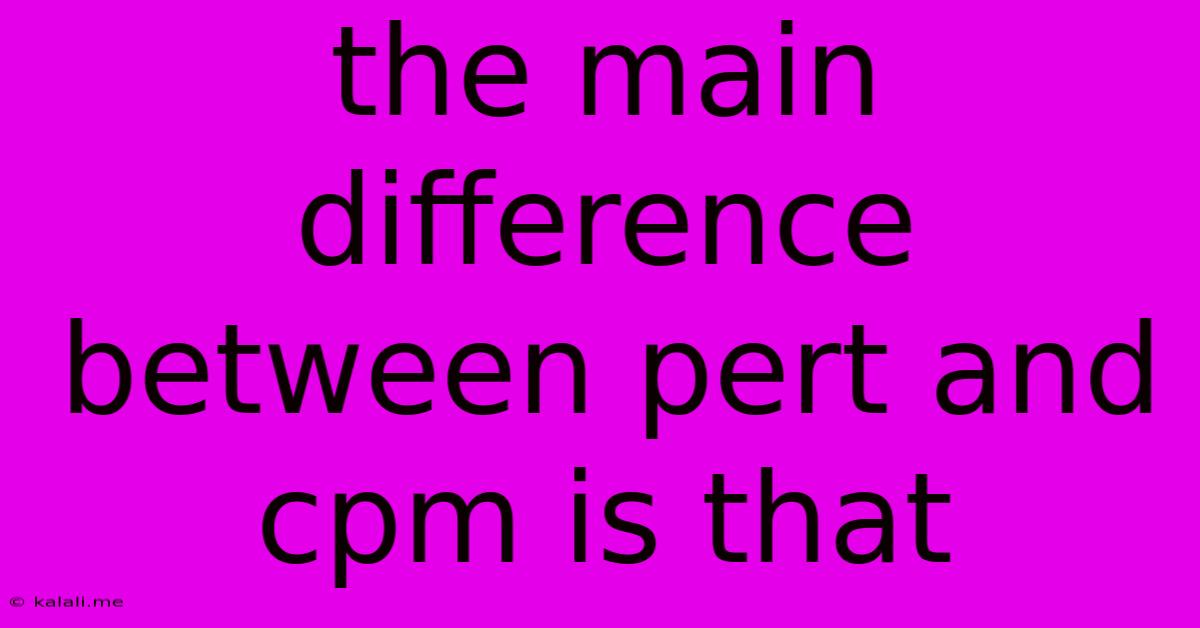The Main Difference Between Pert And Cpm Is That:
Kalali
Jun 13, 2025 · 3 min read

Table of Contents
The Main Difference Between PERT and CPM: A Detailed Comparison
Understanding the nuances between Program Evaluation and Review Technique (PERT) and Critical Path Method (CPM) is crucial for effective project management. While both are powerful tools for scheduling and controlling projects, their core differences lie in how they handle activity durations and uncertainty. This article delves deep into these distinctions, providing a clear understanding of when to use each method.
Meta Description: Discover the key differences between PERT and CPM project management techniques. Learn about their strengths, weaknesses, and when to apply each method for optimal project success. This comprehensive guide clarifies the core distinctions between activity duration estimation and uncertainty handling in both methodologies.
What is PERT?
PERT, or Program Evaluation and Review Technique, is a project management technique best suited for projects with significant uncertainty surrounding activity durations. It uses a probabilistic approach, estimating activity durations using three time estimates:
- Optimistic Time (O): The shortest possible time to complete an activity, assuming everything goes perfectly.
- Most Likely Time (M): The most probable time to complete an activity under normal circumstances.
- Pessimistic Time (P): The longest possible time to complete an activity, considering potential delays and unforeseen issues.
PERT then calculates the expected time (te) for each activity using a weighted average: te = (O + 4M + P) / 6 This expected time incorporates the uncertainty inherent in the project. Furthermore, PERT uses these expected times to determine the critical path, the longest sequence of activities that determines the shortest possible project duration. The probabilistic nature of PERT allows for better risk assessment and management, especially in research and development projects or those with a high degree of novelty.
What is CPM?
CPM, or Critical Path Method, is a deterministic project management technique. Unlike PERT, CPM assumes that activity durations are known with certainty. It uses a single time estimate for each activity, and this estimate is considered fixed. The critical path is determined by identifying the longest sequence of activities, which dictates the shortest project duration. CPM focuses on optimizing project scheduling, minimizing project completion time and cost. It's particularly well-suited for projects with well-defined tasks and predictable durations, such as construction projects or manufacturing processes.
Key Differences Between PERT and CPM: A Table Summary
| Feature | PERT | CPM |
|---|---|---|
| Duration Estimation | Probabilistic (3-time estimates) | Deterministic (1-time estimate) |
| Uncertainty | Accounts for uncertainty in durations | Assumes certainty in durations |
| Time Estimates | Optimistic, Most Likely, Pessimistic | Single, fixed estimate |
| Suitable for | Projects with high uncertainty | Projects with well-defined durations |
| Focus | Risk assessment and management | Scheduling and cost optimization |
| Complexity | More complex calculations | Simpler calculations |
Choosing Between PERT and CPM
The choice between PERT and CPM depends heavily on the nature of the project. If the project involves a high degree of uncertainty or involves novel tasks, PERT's probabilistic approach is more suitable. Its capacity for risk assessment is invaluable in these scenarios. Conversely, if the project has well-defined tasks and predictable durations, CPM's deterministic approach is more efficient. Its focus on cost optimization and efficient scheduling is a strong advantage in these situations. In reality, many projects might benefit from a hybrid approach, leveraging the strengths of both methodologies.
Conclusion
While both PERT and CPM aim to identify the critical path and manage project timelines, their fundamental difference lies in their approach to activity duration estimation. PERT embraces uncertainty, while CPM assumes certainty. Understanding this core distinction is crucial for selecting the right project management technique for optimal project success. Remember to carefully analyze the characteristics of your project before making a decision.
Latest Posts
Latest Posts
-
What Is The Opposite Of Frugal
Jun 14, 2025
-
How To Get Pkb From Kb
Jun 14, 2025
-
What Is The Factors Of 225
Jun 14, 2025
-
Discounting Is The Opposite Of
Jun 14, 2025
-
The Unit Of Measure For Capacitive Reactance Is The
Jun 14, 2025
Related Post
Thank you for visiting our website which covers about The Main Difference Between Pert And Cpm Is That: . We hope the information provided has been useful to you. Feel free to contact us if you have any questions or need further assistance. See you next time and don't miss to bookmark.